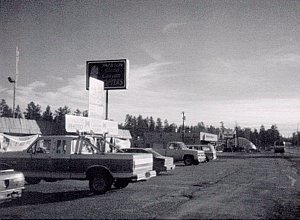

|
|---|

Summer 1998 |
The following article is an excerpt taken from the Summer 1998 issue of the Colorado Plateau Advocate,
a publication of the GRAND CANYON TRUST.

Strip development lining the road to Grand Canyon is cluttered and architectural style conflicts with the natural setting.
|
Gateway to the Grand Canyon
An Opportunity to Excel
Majestic, extraordinary, breathtaking... cluttered, run down, haphazard.
It's hard to believe that this string of seemingly contradictory words can all be accurate descriptions of one of our most cherished treasures: the Grand Canyon. Development in the Grand Canyon's gateway community, Tusayan - and in the National Park itself - is a sorrowful backdrop for this natural wonder. Aside from its aesthetic transgressions (architectural themes and cluttered development patterns completely at odds with the natural setting) there are more serious offenses such as indiscriminate pumping of groundwater that feeds seeps and springs within the Grand Canyon; lack of housing and community services for area residents; and inadequate visitor services for the millions of people who travel to the Grand Canyon each year.
With the escalating numbers of visitors every year and unyielding pressure on existing services, continued development in and around the National Park seems inevitable. However, what type and quality of development is still an open question.
At the Grand Canyon Trust, we believe any development that occurs should be well planned, responsive to the natural resource issues of this incredible landscape, and of a quality and character befitting the splendor of the Grand Canyon. Such development, if it is done right, could turn the gateway to the Grand Canyon from an eyesore to a model gateway community that could serve as an example across the National Park system.
Because of our concern for the Greater Grand Canyon region, the Trust has chosen to be an active voice in advocating environmentally responsible development in and around the Grand Canyon.
With the release this month of the Tusayan Growth Environmental Impact Statement (EIS), our opportunity to turn our concerns into real solutions is imminent. The Kaibab National Forest, in partnership with Grand Canyon National Park and Coconino County has produced the Tusayan Growth EIS, which analyzes eight approaches to dealing with the growth pressures facing the Grand Canyon area. We believe development that meets the highest standards of excellence is the only kind of development that should take place near one of our most treasured National Parks. We have been working closely with the Forest Service to ensure that an alternative that meets this standard appears in the EIS. Details on the environmental alternative are not yet available, but as soon as they are we will be providing an in-depth review to Trust members.
When the Kaibab National Forest releases the EIS, they will identify a preferred alternative, one which they propose for implementation in the Tusayan/Grand Canyon area. We at the Trust are strongly urging Forest Service decision makers to choose an alternative responsive to our environmental concerns:
Watch for the release of the Tusayan Growth EIS, and please spend time evaluating the alternatives that are put forward. We will keep you posted on our plans to continue advocating for lasting, effective growth-management solutions for our namesake: the Grand Canyon.
-- Staff
|
|
|---|
|
|---|